Which Horizon League venue is the toughest place to win? (Updated w/ All Schools)
In the spirit of ESPN’s recently completed review of home court advantage in the nation’s top 10 conferences – welcome to the unofficial rankings for the Horizon League. This is not purely a facility review, but a comprehensive, fact-based (but still totally subjective) look at the overall difficulty of winning at each home court. Regardless of how good the home team happens to be, every trip has its own unique challenges. Enjoy this spin around the League. We look forward to comments, disagreements and counter-arguments over on the Forum.
10. BB&T Arena, Northern Kentucky
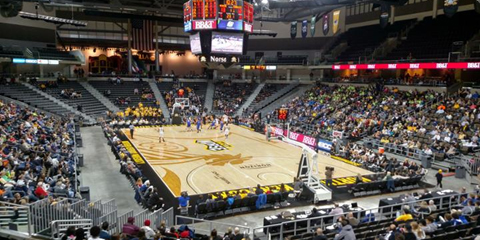
Capacity: 9,400
2016 Average Attendance: 2,296
Percent Filled: 24.4%
Home Winning Percentage (12-13 thru 15-16): 53.8%
Location: On Campus
The Horizon League’s newest, and nicest, home venue is also the most hospitable to opposing teams. The Norse have the second worst home winning percentage over the last four seasons, despite playing in the much weaker Atlantic Sun for three of those years. The sparse crowds (second worst percent capacity filled) are spread out and far removed from the court. Top notch amenities make for a comfortable visiting experience. Plus, travel is a breeze to the League’s southernmost outpost, which is relatively unaffected by winter weather and has easy access to the interstate and the main Cincinnati airport. BB&T does get extra points for having seating around all four sides of the court, something sorely lacking around the league, but until improved teams bring in more fans, it’s still not enough to vault this venue out of last place.
9. UIC Pavilion, UIC
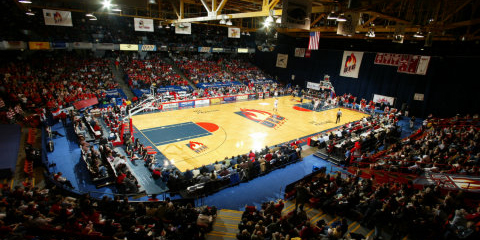
Capacity: 8,000
2016 Average Attendance: 3,166
Percent Filled: 39.6%
Home Winning Percentage (12-13 thru 15-16): 41.7%
Location: On Campus
The UIC Pavilion suffers from two of the most common sins of Horizon League basketball venues, far-removed-fans (thanks to an underlying hockey rink) and seating only on three of the four courtsides. In addition, the reported attendance is as crooked as the city’s politics. No, the stands aren’t filled, like Chicago’s voter rolls, with dead people. Instead, middle school students bussed in for free make up a big part of most UIC home crowds. These “fans” might make it a nightmare for visitors to try and use the restroom, but they apply significantly less pressure to the players on the court. The Flames are the only Horizon League team to have a sub .500 home record over the last four seasons, but it hardly seems fair to put all the blame for that on the facility. The Pavilion still gets the nod over BB&T for two reasons. One, the (non-tweenage) fan base is surprisingly robust relative to the poor on-court results and other available options in Chicago. Two, the building’s odd lower bowl configuration makes the shooting sight lines more difficult for visiting teams. The elevated upper bowl also seems to make the whole space feel smaller (which is a good thing), even if the area is closed to fans and all the seats are empty.
8. Wolstein Center, Cleveland State
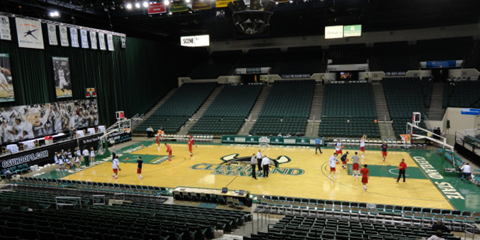
Capacity: 13,610
2016 Average Attendance: 1,911
Percent Filled: 14.0%
Home Winning Percentage (12-13 thru 15-16): 66.7%
Location: On Campus
The League’s largest venue is unfortunately paired with its smallest fan base. With just 14% of its massive capacity filled last season the Wolstein Center is hardly an intimidating environment. Designed with bowl seating on all four sides, one end-zone is perpetually blocked off by a giant green curtain and blown up image of cheering fans. The sheer size of the mostly empty space and the unusual curtain set up do make this a difficult shooting environment for visitors (especially when faced with a typical Gary Waters’ defense, although we can’t credit that to the building). Situated just east of downtown Cleveland near Lake Erie, lake-effect snow can be a serious issue for travelers, but in general “The Land” is a major enough hub to not present too many travel headaches for opponents.
7. Calihan Hall, Detroit
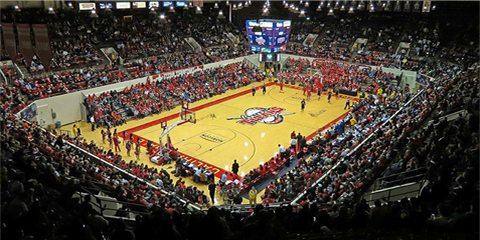
Capacity: 8,295
2016 Average Attendance: 2,121
Percent Filled: 25.6%
Home Winning Percentage (12-13 thru 15-16): 68.9%
Location: On Campus
Calihan Hall is the first real basketball arena on the list and – with the departure of Butler/Hinkle Fieldhouse – it is also the League’s most historical venue. Calihan has a lot going for it, especially considering how lowly it is ranked. The building has character, is designed primarily for basketball and the seats are close to the action on all four sides of the competition area. Unfortunately Calihan lacks the single most important ingredient for a great home court – fans. Despite fielding some very good teams the Titans can’t get any traction in Motor City, and anyone who has been to the UDM campus will understand why. It is surrounded by urban blight and is just too far removed from both suburban fans and the small areas of redevelopment around the city’s pro sports venues and casinos. As a result, the atmosphere is almost always idyllic. More akin to the half-hearted interest of a summer league than the intensity of a great late winter conference duel. A once-a-year exception for when the stands are half full of Oakland fans is not enough to bump Calihan higher up the list.
6. Beeghly Center, Youngstown State
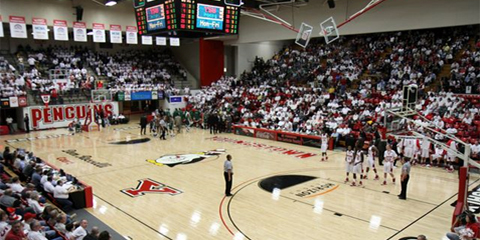
Capacity: 6,300
2016 Average Attendance: 2,013
Percent Filled: 32.0%
Home Winning Percentage (12-13 thru 15-16): 57.6%
Location: On Campus
Given YSU’s status as the League doormat, the Beeghly Center at number 6 has to be one of the surprises of the list. Yet, the truth is the home court advantage there might still be underrated. It is one of just three venues that is not dramatically oversized relative to its potential fan base and it has seating close to the action on all four sides of the court and the lowest ceiling in the League. As a result even relatively sparse crowds can make significant noise here. Plus, Youngstown, at the eastern edge of the League, is not the easiest spot to get to without a charter plane – which are usually few and far between for mid-majors. Although a 57.6% home winning percentage is generally pretty weak, in the case of the Penguins it’s actually impressive relative to the overall quality of their teams. If YSU could string together a couple seasons in the top third of the League their football first fans could easily turn the Beeghly Center into one of the Horizon’s toughest home courts.
5. Panther Arena, Milwaukee
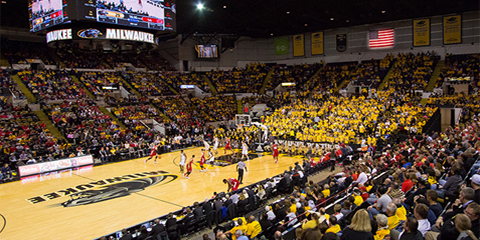
Capacity: 10,783
2016 Average Attendance: 2,667
Percent Filled: 24.7%
Home Winning Percentage (12-13 thru 15-16): 63.5%
Location: Off Campus
If any current League venue could challenge Calihan Hall’s recently bestowed “most historical” superlative it’s the MECCA err…US Cellular, uh I mean Panther Arena. This large venue in downtown Milwaukee feels and smells like something from an earlier era (and that is a compliment). Unfortunately, the last decade of mediocre basketball has seriously decimated what was one of the league’s larger fan bases and better student sections. And the unfortunate truth is that even when the Panthers were rolling, this venue, like so many across the League, is just too big. With the last four years of mostly average teams combined with an average winning percentage of 63.5% – the number five spot seemed like the perfect place for Panther Arena. Bonus points for serving beer and for the plethora of great bar options nearby.
4. Nutter Center, Wright State
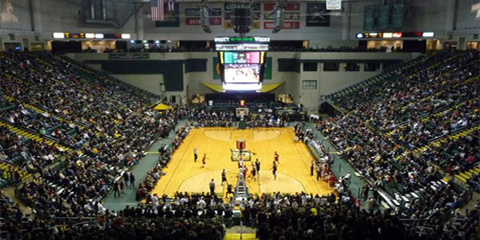
Capacity: 10,400
2016 Average Attendance: 4,355
Percent Filled: 41.9%
Home Winning Percentage (12-13 thru 15-16): 70.7%
Location: On Campus
The league’s most robust fan base powers Wright State’s home court advantage. Despite winning no championships (tournament or regular season) in the last nine years, the Raiders still average the most fans in the League (and are the only program to top out over 4,000 per game). In addition to a solid fan base, the Nutter Center boasts steep climbing bleachers around three sides of the court and an intimidating terrace on the third empty side (the best arrangement possible if you can’t have seats there). The steep pitch of the bowl combined with a high ceiling create an unusual environment on the court that can throw visiting teams off their game. However, the cavernous space, distance of the fans from the court (as dictated by the facility’s multi-purpose design) and the over-abundance of seats usually keeps the atmosphere from achieving a true fever pitch. However, anyone who saw the 2007 Horizon League championship game knows what the Nutter Center is capable of, and more importantly the Raiders relatively strong fan support keeps this building closer to that full potential than most other spots in the League.
3. Resch Center, Green Bay
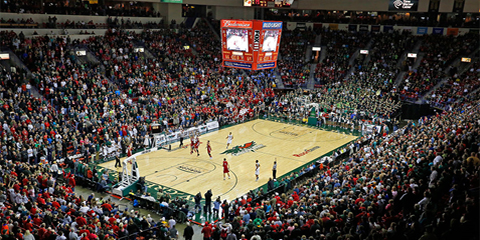
Capacity: 9,877
2016 Average Attendance: 3,029
Percent Filled: 30.7%
Home Winning Percentage (12-13 thru 15-16): 84.2%
Location: Off Campus
It is truly tough to win at the Resch Center. Valpo is the only team in the league to have done so more than once in the last four seasons, while four teams haven’t notched any wins there during that time. In addition, both Marquette and (future number 1 seed) Virginia have been recently bounced out of the Resch with losses. Let’s start with travel. Wind, snow and general weather misery can make just getting to the league’s northernmost venue a challenge. The building itself sports seats that rise steeply on all four sides of the court, although the underlying ice rink keeps the fans, especially the students on the baselines, too far from the action. The arena is off-campus near Lambeau Field, which may actually increase general fan attendance but seems to hurt student turn out. However, the general fan support is very strong, so long as there isn’t a conflict with the Packers. All in all, this is a tough trip, with barely 15% of teams earning wins, the second best home winning percentage in the League.
2. Athletics Center O’rena, Oakland
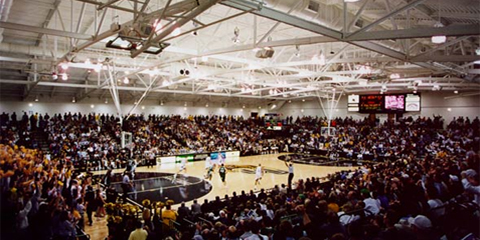
Capacity: 3,000
2016 Average Attendance: 3,097
Percent Filled: 103.2%
Home Winning Percentage (12-13 thru 15-16): 74.1%
Location: On Campus
If Oakland truly averaged a sellout each game they would claim the top spot in this ranking. But they didn’t. Their officially listed capacity or attendance numbers are clearly off, as anyone who tuned in on ESPN3 for more than a couple games could see (best guess – the actual capacity is 4,000 not 3,000). Regardless, this is still a great venue and without a doubt one of the League’s toughest spots to earn a W. The O’rena was built specifically with Oakland basketball in mind –not minor league hockey or concerts like so many of the League’s multi-use venues. The fans are close to the action, surrounding the court on all sides with black and gold. The capacity is the perfect size for Oakland’s fledgling fan base. Rabid student support might be the single most important factor in creating an intimidating home environment and the Grizzlies have the second best student section in the League. In addition, Oakland seems to be the most aggressive and effective school at artificially pumping up the atmosphere when organic support is underwhelming. Purists might scoff at this, but the reality is that no Horizon League school has the kind of atmosphere that doesn’t occasionally need a boost, and if you have to do it, you might as well be good at it. On the negative side, Oakland’s home winning percentage is 10% worse than the League’s top two in this metric, which is a little surprising considering the general quality of their teams. Despite sporting unusual ceiling hung backboards (a rarity at the college level – and a direct call out to Duke’s fearsome Cameron Indoor Stadium) the O’rena rims seem as kind to visitors as to the offensively-minded Grizzlies.
1. Athletics-Recreation Center “The ARC”, Valparaiso

Capacity: 5,000
2016 Average Attendance: 3,572
Percent Filled: 71.4%
Home Winning Percentage (12-13 thru 15-16): 86.2%
Location: On Campus
This is the Horizon League’s nightmare trip. First, unless you pay to charter you are at least an hour away from the nearest commercial airport – and that’s assuming no Chicago traffic snarls or lake effect snow. Second, Valpo is by far the smallest stop on the League circuit. Locals may be proud of the revitalized downtown, but to visiting teams and their fans Valparaiso is just another sleepy hamlet in the uber-blandness of northern Indiana. In fact most visiting teams choose to stay in hotels nearer to the interstate in Merrillville or Chesterton for fear of how conspicuous they will be in small town Valparaiso. As for the ARC, it is (to put it delicately) the least inviting facility in the League. A couple seasons ago Green Bay coach Brian Wardle nearly broke his leg just trying to get in an icy side door. Next, there is no dedicated visitor’s locker room. Instead all away teams are housed in the football team’s locker room – complete with wall mounted gang showers and the pleasant after aroma of a season’s worth of Crusader football. The ARC is the league’s second smallest venue, with seats packed close to the court, and up to the rafters. In a rare set up, fans on one sideline are completely unobstructed from the court, no scorer’s table, not even a rope, nothing. Valpo also features the largest and most engaged student section in the league, sitting just feet from the visitor’s bench. Between the fans and the venue the atmosphere can be absolutely suffocating for away teams. However, even the League’s best has its drawbacks. The east baseline is basically empty of seats, somewhat reducing the claustrophobic atmosphere and despite the best five year stretch since Bryce Drew was in uniform the fan base still has not grown back to the capacity levels achieved in the afterglow of the 1998 Sweet Sixteen. Even the students can be no shows for mid-week and Sunday games. Despite these problems, all rankings are relative and Valpo is without a doubt the class of the Horizon League when it comes to home court advantage.
Days since Last Victory against Valpo in the ARC (8/16/16) – But who’s counting? 🙂
Northern Kentucky – No wins. (Only one attempt)
Wright State – 185 (Won most recent game)
Cleveland State – 899
Detroit – 921
Milwaukee – 1,692
Oakland – 1,704
Green Bay – 2,032
Butler – 2,363
UIC – 2,739
Youngstown State – 6,779
Conclusion
In the grand scheme of NCAA Division I the Horizon League draws fairly middling crowds into relatively large venues. Unfortunately, this is a poor recipe for electric home atmospheres. The league is filled with economical “multi-use” facilities for which college basketball is never the primary activity. Absent large fan bases that could make any building rock, the dictum “form follows function” is especially vital for Horizon League home courts. As such, venues made specifically for mid-major college basketball (the ARC, the O’rena and even to some extent the Beeghly Center) rose at the expense of those facilities with other priorities.